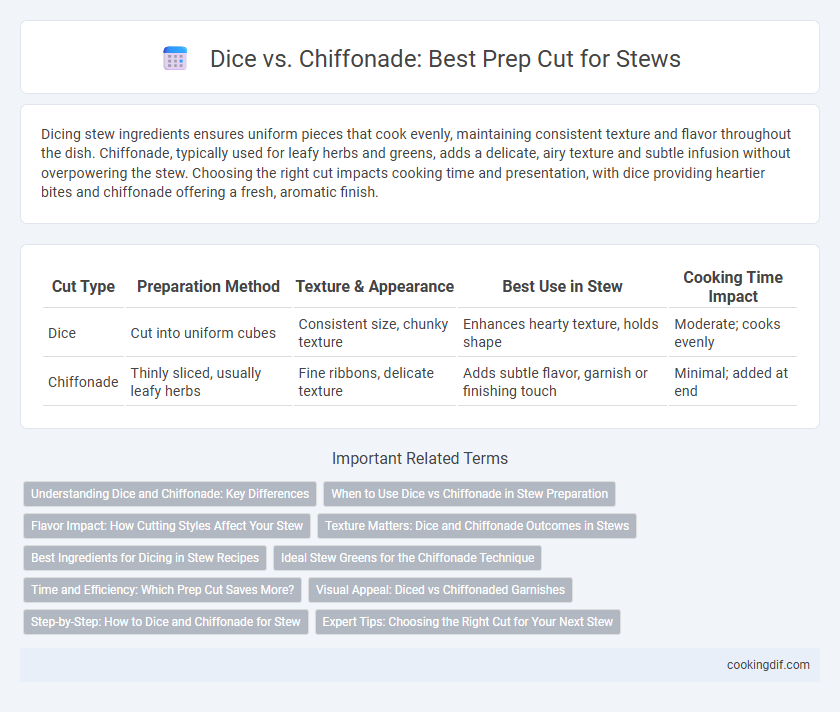Dicing stew ingredients ensures uniform pieces that cook evenly, maintaining consistent texture and flavor throughout the dish. Chiffonade, typically used for leafy herbs and greens, adds a delicate, airy texture and subtle infusion without overpowering the stew. Choosing the right cut impacts cooking time and presentation, with dice providing heartier bites and chiffonade offering a fresh, aromatic finish.
Table of Comparison
| Cut Type | Preparation Method | Texture & Appearance | Best Use in Stew | Cooking Time Impact |
|---|---|---|---|---|
| Dice | Cut into uniform cubes | Consistent size, chunky texture | Enhances hearty texture, holds shape | Moderate; cooks evenly |
| Chiffonade | Thinly sliced, usually leafy herbs | Fine ribbons, delicate texture | Adds subtle flavor, garnish or finishing touch | Minimal; added at end |
Understanding Dice and Chiffonade: Key Differences
Dice and chiffonade are two distinct knife techniques essential for stew preparation, each impacting texture and cooking time. Dicing involves cutting ingredients into uniform cubes, ensuring even cooking and consistent flavor distribution, while chiffonade creates thin, ribbon-like strips typically used for herbs or leafy greens to release aroma and delicate taste. Selecting the appropriate cut enhances the stew's overall mouthfeel and presentation by balancing ingredient size and flavor release.
When to Use Dice vs Chiffonade in Stew Preparation
Use dicing for stew ingredients like carrots, potatoes, and onions when you want uniform, bite-sized pieces that cook evenly and blend well into the broth. Chiffonade is ideal for leafy herbs like basil or spinach, adding delicate texture and a fresh burst of flavor toward the end of cooking. Choosing the right cut enhances both the stew's texture and flavor balance, optimizing the overall dish quality.
Flavor Impact: How Cutting Styles Affect Your Stew
Dice cutting creates uniform chunks that retain juices and promote even cooking, enhancing the stew's rich, robust flavor. Chiffonade, a technique typically reserved for herbs or leafy greens, releases aromatic oils quickly, adding bright, fresh notes to the dish. Choosing between dice and chiffonade directly influences the stew's texture and flavor intensity by controlling how ingredients infuse during simmering.
Texture Matters: Dice and Chiffonade Outcomes in Stews
Dice cuts create uniform, chunky pieces that hold their shape well during long cooking times, contributing a hearty texture to stews. Chiffonade, typically used for leafy herbs, results in delicate, thin ribbons that dissolve quickly, infusing the stew with subtle aroma and flavor without altering its chunky consistency. Choosing between dice and chiffonade depends on whether the goal is to maintain distinct vegetable textures or to blend fresh herb notes seamlessly into the stew.
Best Ingredients for Dicing in Stew Recipes
For stew recipes, the best ingredients for dicing are root vegetables like carrots, potatoes, and parsnips, as their firm texture holds up well during slow cooking. Dice provides uniform pieces that ensure even cooking and a balanced distribution of flavors throughout the stew. Unlike chiffonade, which is ideal for delicate herbs or leafy greens, dicing is essential for hearty vegetables that form the stew's robust base.
Ideal Stew Greens for the Chiffonade Technique
Chiffonade technique is ideal for tender stew greens like spinach, Swiss chard, and kale, slicing leaves into fine, ribbon-like strips that melt into the stew for a delicate texture and even flavor distribution. Dice cuts suit heartier vegetables, but chiffonade preserves the integrity of leafy greens without overcooking or bruising them. Using chiffonade ensures greens retain vibrant color and subtle aroma, enhancing the overall stew's depth.
Time and Efficiency: Which Prep Cut Saves More?
Dicing vegetables for stew provides uniform pieces that cook evenly but requires more precise knife skills and time to achieve consistent sizes. Chiffonade, typically used for leafy herbs or greens, is significantly faster, slicing leaves into thin ribbons with minimal effort and speed. For stew preparation where bulk and cooking uniformity matter, dicing saves more time by ensuring even cooking, though chiffonade excels in efficiency for quick herb additions.
Visual Appeal: Diced vs Chiffonaded Garnishes
Diced garnishes in stew preparation create a structured, evenly shaped presentation that enhances visual appeal through uniformity and color contrast. Chiffonade, with its delicate, ribbon-like cuts, adds a light, airy texture that contributes to a sophisticated, layered look atop the dish. Choosing between diced and chiffonaded garnishes depends on the desired aesthetic impact, where diced offers bold definition and chiffonade provides elegant softness.
Step-by-Step: How to Dice and Chiffonade for Stew
To dice for stew, start by peeling and trimming the vegetables, then cut them into uniform cubes, typically about 1/2 inch, ensuring even cooking. For chiffonade, stack leafy greens, roll them tightly into a cigar shape, then slice thinly to create fine ribbons ideal for garnishing. Precise dicing ensures hearty texture in stew, while chiffonade adds a delicate, fresh finish.
Expert Tips: Choosing the Right Cut for Your Next Stew
Dice offers uniform chunks that cook evenly and retain texture in stews, ideal for hearty, rustic recipes. Chiffonade, typically reserved for herbs or leafy greens, infuses delicate flavor without overpowering the dish. Expert chefs recommend dicing root vegetables and tougher ingredients while chiffonading fresh herbs to layer flavor and balance texture in your next stew.
Dice vs Chiffonade for prep cut Infographic

 cookingdif.com
cookingdif.com